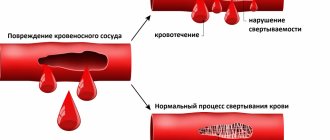Detailed description of the study
APTT - activated partial thromboplastin time - a test to assess the state of the blood coagulation system. The study is carried out by adding substances to citrated platelet-poor plasma that help directly assess the functioning of plasma factors. They are proteins that play a key role in the formation of a blood clot.
The hemostatic system is a set of various mechanisms aimed at maintaining a balance between coagulation and anticoagulation factors in the blood. This avoids the pathological formation of blood clots (thrombi) or the tendency to bleed.
The formation of a blood clot (thrombus) occurs in several stages. A primary thrombus is formed by gluing blood platelets - platelets - to each other. Next, special proteins - coagulation factors - are included in the process. These proteins are produced in the liver. The result of their action is the conversion of prothrombin into thrombin under the influence of factor III (thromboplastin) and the formation of a secondary thrombus.
Activated partial thromboplastin time is the period during which a clot is formed in a test tube along with special substances that imitate the action of coagulation factors. The purpose of the test is to assess the state of the so-called intrinsic coagulation pathway (involving factors VIII, IX, XII, XI).
Prolongation of APTT in adults and children indicates hypocoagulation - a decrease in the ability to form blood clots. This increases the risk of bleeding. This can occur with hereditary and acquired defects in coagulation factors. Hereditary - hemophilia A and B, von Willebrand disease, hereditary factor XI deficiency. Acquired ones are caused by disruption of the liver, where coagulation factors are formed, exposure to anticoagulants, severe infectious diseases, and oncological processes.
The shortening of activated partial thromboplastin time reflects the predominance of hypercoagulation - increased blood clotting. A similar situation can be observed with thrombosis, including disseminated intravascular coagulation (DIC) syndrome in the hypercoagulation stage. Early diagnosis of coagulation disorders allows you to avoid serious consequences.
There are also physiological conditions under which a shortening of the APTT is observed—pregnancy.
The APTT indicator is used for monitoring during treatment with heparin in order to track the moment of excessive blood thinning. During myocardial infarction, the duration of clot formation determines the effectiveness of anticoagulant treatment, which indirectly reflects vascular patency.
Thus, determining the APTT helps to quickly assess the state of hemostasis, together with other data, suspect severe congenital and acquired diseases, and prescribe timely treatment.
Activated partial thromboplastin time, or aPTT, is the time it takes for a blood clot to form after calcium chloride and other reagents are added to the plasma. It reflects the work of the so-called internal pathway and the general cascade of the human blood coagulation system and is the most sensitive indicator of blood coagulation.
Synonyms Russian
Activated partial thromboplastin time, cephalin-kaolin time.
English synonyms
Partial Thromboplastin Time (PTT), Activated Partial Thromboplastin Time, aPTT, APTT.
Research method
Side scatter detection method, end point percentage determination.
Units
Sec. (second).
What biomaterial can be used for research?
Venous blood.
How to properly prepare for research?
- Do not eat for 12 hours before the test.
- Avoid physical and emotional stress 30 minutes before the test.
- Do not smoke for 30 minutes before the test.
General information about the study
Activated partial thromboplastin time (aPTT) characterizes the intrinsic pathway of blood coagulation. APTT is the time it takes for a clot to form in a blood plasma sample after adding special activators of this process. In this way, the degree of influence of blood clotting factors on the formation of a blood clot is assessed.
The duration of APTT depends on the level of high molecular weight kininogen, prekallikrein and coagulation factors XII, XI, VIII and is less sensitive to changes in the amount of factors X, V, prothrombin and fibrinogen. APTT is determined by the duration of blood clot formation after calcium and partial thromboplastin are added to the blood sample. An increase in aPTT duration is associated with an increased risk of bleeding, while a decrease is associated with thrombosis. This indicator is used separately to monitor therapy with direct anticoagulants (heparin).
What is the research used for?
- For the diagnosis of hemophilia.
- To monitor heparin anticoagulant therapy.
- For the diagnosis of deep hypofibrinogenemia, dysfibrinogenemia and disorders of fibrin monomer polymerization.
- To determine the patient’s predisposition to bleeding (as part of preoperative procedures).
When is the study scheduled?
- If the patient has bleeding or bruising of unknown origin, thromboembolism or disseminated intravascular coagulation, which can cause both bleeding and blood clots.
- When carrying out heparin therapy or when transferring a patient from heparin therapy to long-term treatment with warfarin.
- As part of a preoperative examination to identify the body's tendency to bleed, especially if the proposed operation is associated with a large loss of blood or the patient's clinical history indicates earlier bleeding.
- In the treatment of myocardial infarction.
What do the results mean?
Reference values: 21.1 - 36.5 sec.
An increase in aPTT indicates a tendency to bleed: blood clotting lasts longer than usual, which often indicates a deficiency in one of the coagulation factors or the effect of some inhibitor on the body's ability to form clots.
What can influence the result?
- The presence of impurities of direct anticoagulants (in particular, heparin) in the blood sample
- High concentration of lipids (fats) in the blood, for example, after eating a fatty meal the night before the test
Coagulogram: everything you need to know about coagulation
Blood coagulation is a multi-stage, complex process and, at the same time, sensitive to the action of a number of factors. At the same time, the symptoms of “problems”, as a rule, do not make themselves felt for a long time. And clotting tests often reveal abnormalities “by chance.” So who should keep hemostasis “under supervision”? And how can those who are already undergoing treatment understand the indicators?
Who is the analysis for?
Blood clotting testing is primarily indicated for those who:
- suffers from liver disease or has had hepatitis in the past (since most clotting factors are synthesized in the liver);
- suffers from or has a hereditary predisposition to thrombophlebitis and varicose veins;
- suffers from cardiovascular or autoimmune diseases (high risk of vascular inflammation and, as a result, increased thrombosis);
- takes oral contraceptives or has excess estradiol (women);
- miscarriage in the patient’s personal history
Significant risk factors such as smoking, excess weight, sedentary lifestyle, age over 40, frequent flights and others should not be excluded from attention.
And, of course, such an analysis is mandatory before any operation, as well as for those who are already taking “anti-coagulant” drugs.
What the indicators say
The set of “standard” coagulograms (50.0.H94.203) includes the definition of:
- APTT,
- Prothrombin (time, INR),
- Thrombin time
- Fibrinogen.
But what do these indicators mean?
1. APTT, or activated partial thromboplastin time
Estimates the rate of blood clot formation after adding special reagents to plasma, and is measured in seconds.
In other words, APTT demonstrates the effectiveness of stopping bleeding due to plasma coagulation factors (precisely those that are formed in the liver).
At the same time, a lengthening (increase) of the indicator signals the risk of bleeding, and a shortening indicates thrombosis.
And the analysis is especially “relevant” for people taking direct anticoagulants (heparin and others).
2. Prothrombin time (PT)
This is the time period during which the formation of fibrin threads, that is, the actual precursor of a blood clot, occurs.
The indicator is measured as a percentage of the norm, which is 70-120%.
The higher this indicator, the higher the rate of thrombus formation, and therefore the risk of thrombosis.
A decrease in PV is a signal of a tendency to bleeding.
3. INR
In essence, it is a calculated indicator designed to standardize data on prothrombin time obtained using different equipment.
Such “difficulties” have become necessary due to the fact that INR is the basic analysis for the selection and correction of “anticoagulant” drugs (such as warfarin). And data obtained on different equipment (in different laboratories) often did not allow comparison with each other.
Therefore, the International Committee for Standardization in Hematology and the International Committee on Thrombosis and Haemostasis introduced the use of INR in 1983.
And today, its level for a healthy person is at the level of 0.8-1.2. And for those taking indirect anticoagulants – 2.0-4.0.
At the same time, an increase in INR is associated with the risk of bleeding, and a decrease of less than 0.5 may indicate thrombosis.
4. Fibrinogen
Unlike previous indicators, this is directly a substrate for the formation of a blood clot. That is, not an indicator of speed, but a substance. Therefore, the norms for fibrinogen are measured in grams per liter.
An increase in fibrinogen is observed not only with increased thrombus formation, but also with many inflammatory processes (as a way for the body to limit the spread of the “causal factor” and destroyed tissues). And also for those who take oral contraceptives or have elevated estrogen levels, pregnant women, people with high cholesterol and smokers.
A decrease in the indicator can indicate not only the risk of bleeding, but also liver disease.
Of course, the listed indicators are only a “base” for assessing the “health” of the blood coagulation system. And if significant deviations are detected, additional markers may be needed.
Complexes with this research
Entry into IVF Examination when a woman enters the IVF procedure 23,020 ₽ Composition
Miscarriage Identification of the main causes of miscarriage 40,070 ₽ Composition
Coagulogram Study of the functional state of hemostasis RUB 2,020 Composition
IN OTHER COMPLEXES
- Pregnancy planning. Clinical indicators RUB 6,630
- Examination during pregnancy. 1st trimester 16,690 RUR
- Female infertility RUB 16,210
- Extended coagulogram RUB 4,150
- Examination during pregnancy. 3rd trimester 9,620 RUR
Activated partial thromboplastin time (aPTT)
Activated partial thromboplastin time, or aPTT, is the time it takes for a blood clot to form after calcium chloride and other reagents are added to the plasma. It reflects the work of the so-called internal pathway and the general cascade of the human blood coagulation system and is the most sensitive indicator of blood coagulation.
Synonyms Russian
Activated partial thromboplastin time, cephalin-kaolin time.
English synonyms
Partial Thromboplastin Time (PTT), Activated Partial Thromboplastin Time, aPTT, APTT.
Research method
Side scatter detection method, end point percentage determination.
Units
Sec. (second).
What biomaterial can be used for research?
Venous blood.
How to properly prepare for research?
- Do not eat for 12 hours before the test.
- Avoid physical and emotional stress 30 minutes before the test.
- Do not smoke for 30 minutes before donating blood.
General information about the study
Activated partial thromboplastin time (aPTT) characterizes the intrinsic pathway of blood coagulation. APTT is the time it takes for a clot to form in a blood plasma sample after adding special activators of this process. In this way, the degree of influence of blood clotting factors on the formation of a blood clot is assessed.
The duration of APTT depends on the level of high molecular weight kininogen, prekallikrein and coagulation factors XII, XI, VIII and is less sensitive to changes in the amount of factors X, V, prothrombin and fibrinogen. APTT is determined by the duration of blood clot formation after calcium and partial thromboplastin are added to the blood sample. An increase in aPTT duration is associated with an increased risk of bleeding, while a decrease is associated with thrombosis. This indicator is used separately to monitor therapy with direct anticoagulants (heparin).
What is the research used for?
- For the diagnosis of hemophilia.
- To monitor heparin anticoagulant therapy.
- For the diagnosis of deep hypofibrinogenemia, dysfibrinogenemia and disorders of fibrin monomer polymerization.
- To determine the patient’s predisposition to bleeding (as part of preoperative procedures).
When is the study scheduled?
- If the patient has bleeding or bruising of unknown origin, thromboembolism or disseminated intravascular coagulation, which can cause both bleeding and blood clots.
- When carrying out heparin therapy or when transferring a patient from heparin therapy to long-term treatment with warfarin.
- As part of a preoperative examination to identify the body's tendency to bleed, especially if the proposed operation is associated with a large loss of blood or the patient's clinical history indicates earlier bleeding.
- In the treatment of myocardial infarction.
What do the results mean?
Reference values: 21.1 - 36.5 sec.
An increase in aPTT indicates a tendency to bleed: blood clotting lasts longer than usual, which often indicates a deficiency of one of the coagulation factors or the effect of some inhibitor on the body's ability to form thrombosis.
What can influence the result?
- The presence of impurities of direct anticoagulants (in particular, heparin) in the blood sample
- High concentration of lipids (fats) in the blood, for example, after eating a fatty meal the night before the test
Important Notes
- When very high doses of heparin are used, for example during open heart surgery, the APTT test loses its sensitivity - thrombus formation is greatly reduced.
- The APTT test is not prescribed as a routine screening test. It is needed if the patient’s medical history indicates a hereditary tendency to thrombosis or hemophilia. Asymptomatic patients are often screened for aPTT before surgery, especially when their physician believes it will help determine the risk of excess bleeding during surgery.









